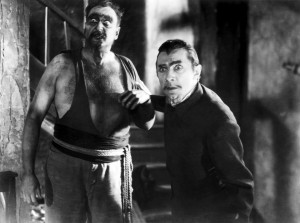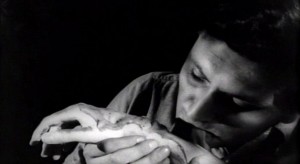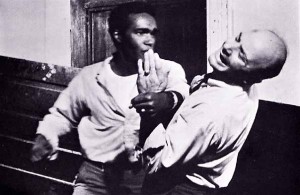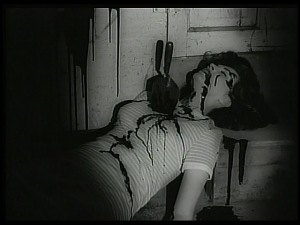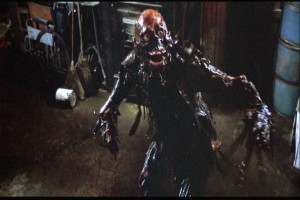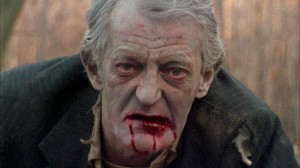100 Film Favorites – #44: “Night of the Living Dead”
(George Romero, 1968)
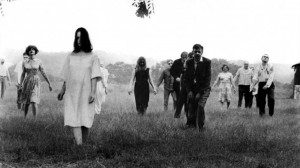 “They’re coming to get you, Barbra!”
“They’re coming to get you, Barbra!”
In a near-180 degree shift from yesterday’s iconic Christmas special, we now come to a film which still consistently ranks among the scariest horror films ever made. It’s Night of the Living Dead, the movie which launched the modern zombie genre and inspired the MPAA ratings system.
As mentioned in the post on Fritz Lang’s M, the Hollywood Production Code of the 1930s strictly defined what was permissible to be shown in motion pictures. Sexual activity, profanity, drug use, and gratuitous violence were mostly forbidden, as was the depiction of criminals in a glorified or positive light. Characters who transgressed needed to be punished. This Code was rigidly enforced from the second half of the 30s, through the 40s and into the 50s. But by the 1960s, the Production Code censors had loosened their grip on the industry. Society became more accepting of subject matter which was once taboo, and filmmakers were able to get away with more “edgy” fare in their movies.
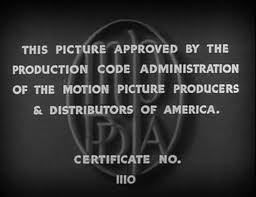
Enter George Romero. A Carnegie-Mellon film student in Pittsburgh, the young Romero grew bored shooting commercials (and industrial shorts for the “Picture-Picture” segment of the fledgling children’s series Mr. Rogers’ Neighborhood), and began planning to make an independent horror film with his friend, screenwriter John Russo. In the summer of 1967, they began production on a film tentatively titled “Night of Anubis,” then “Night of the Flesh-Eaters.” The distributor they eventually found balked at the title’s similarity to an earlier film, “The Flesh Eaters,” and slapped an alternate title on the opening credits: “Night of the Living Dead.” This new title-card bore no copyright information, and thus the film entered the public domain upon its release, making it quite possibly the most famous and critically acclaimed movie in the PD.
In 1968, “Zombie movies” were not an entirely new idea. Zombies as defined in Haitian voodoo culture had already appeared several times in Hollywood films. The earliest such appearance was in 1932’s White Zombie, starring Bela Lugosi. But these zombies were hypnotized slaves who mindlessly did the bidding of a shaman or witch doctor.
Romero amped up the scare factor by combining the Haitian zombie’s brainless, shambling gait with the insatiable hunger of the vampire. His zombies would be walking corpses, reanimated by some mysterious, unexplained force, which hungered ceaselessly for the flesh of the living. What’s more, they’d be shown eating it!
As the first “modern” zombie movie, the film also introduces many of the “rules” still associated with zombies in modern fiction:
-Zombies are slow and shambling, easy to outrun but intimidating because they never tire or stop hunting.
-The only way to really “kill” them is to destroy the brain with a gunshot or heavy blow to the head.
-And, as with vampire or werewolf rules, if you get bitten by a zombie, you become one.
The film sets up the archetypal plot structure of the zombie film: The dead arise, hungry for some fresh man-chops. A ragtag band of survivors holes up in a fortified location to wait out the undead siege. Tensions mount between the group members, and soon the violence between the living is more of a threat than the ghouls outside. An act of careless violence compromises the security of the group’s shelter, and the dead swarm in. As the zombies chow down, we are reminded that the greatest threat to man’s survival is our inability to get along.
There’s a bit more to the story than that, but that’s the gist. We do get some interesting insight into the nature of the unfolding plague, as the survivors locate a radio and then a television set in the farmhouse they’ve holed up in. We learn that the cause of the “resurrection” is unknown, with one scientist blaming it on unusual radiation emitted by a space probe recently returned from Venusian orbit. A helpful local sheriff explains the “shoot ’em in the head” rule, and we see that local posses of redneck hunters have had some success combating the zombies. Actually, this is one of the few zombie movies which ends with humans successfully corralling and controlling the outbreak – though salvation comes too late for our protagonists.
Night of the Living Dead depicts a level of gore not previously seen in American cinema up to that point. While there aren’t any shots of zombies actually biting the flesh off living people (that would come with the makeup wizardry of Tom Savini in the sequel, 1978’s Dawn of the Dead), there’s plenty of scenes of the ghouls joyfully nomming on assorted entrails. This unprecedented degree of gore shocked audiences, particularly because the film was widely shown as a Saturday matinee (a common practice with the campy horror films of the era). This meant the movie was seen in theaters by many children. As the Roger Ebert of 45 years ago observed, “The kids in the audience were stunned. There was almost complete silence. The movie had stopped being delightfully scary about halfway through, and had become unexpectedly terrifying. There was a little girl across the aisle from me, maybe nine years old, who was sitting very still in her seat and crying.”
I can relate: I was first introduced to old horror & sci-fi films through a Friday night block on a local PBS station, which would show a different campy movie each week. These films included schlocky classics like The Crawling Hand and The Hideous Sun Demon, and I watched nearly every week. Then, when I was nine, they aired Night of the Living Dead. It was so much scarier and more visceral than any of the other films I’d seen that I stopped watching the program for about two years… after which I returned to find that the station had gone off the air. Sad.
The modern MPAA rating system was introduced to replace the old Production Code just months after the release of Night of the Living Dead. While other films may have motivated the creation of the system, Romero’s gore-fest most highlighted its importance. So the next time you see a movie has an R rating, just remember Romero, the man who helped put it there. And even if you are sick and tired of the ubiquity of zombies in modern pop culture, remember that they wouldn’t be there at all were it not for this movie. In 1999 the film was added to the National Film Registry for being “culturally, historically, or aesthetically significant” – and it certainly has been.
Tidbits:
-In addition to spawning an entire subgenre of horror (which has exploded in popularity in the past decade), Night of the Living Dead has inspired multiple sequels and remakes. It actually stands as the first film in two separate series: After the film lost its copyright status, Romero and Russo bickered over who really “created” the movie. They ultimately split apart, with Romero continuing to direct his “of the Dead” series (Dawn of the Dead (1978), Day of the Dead (1985), Land of the Dead (2005), Diary of the Dead(2007), and Survival of the Dead(2010) ), while Russo went on to create the Return of the Living Dead series beginning in 1985. It’s in Russo’s first “sequel” that the go-to zombie catchphrase, “BRAAAAAINS!” is first uttered by a member of the walking dead.
-The film also had a semi-official remake in 1990. Directed by Tom Savini (the makeup and gore effects creator for all subsequent “of the Dead” movies) and given George Romero’s blessing, the remake is actually pretty good. The same cannot be said of the 1998 “30th Anniversary” release of the original film, in which Russo haphazardly inserted new footage. The only actor to return for these additional scenes was Bill Hinzman, the first zombie to appear in “Night“…but it’s very apparent that he’s suddenly three decades older.
-In the first issue (and episode) of The Walking Dead, sheriff Rick Grimes is given shelter by an African-American man named Morgan Jones. Morgan has a young son named Duane…a reference to Duane Jones, the actor who played Ben, Night of the Living Dead‘s main protagonist.
-The film’s soundtrack consists of various stock music to which the filmmakers had access. Bits and pieces of the music are recognizable in other sci-fi and horror films of the period, including The Hideous Sun Demon and previous Countdown selection Teenagers from Outer Space.
—
Brian Terrill is the host of television show Count Gauntly’s Horrors from the Public Domain. You can keep up with Brian’s 100 Film Favorites countdown here.



